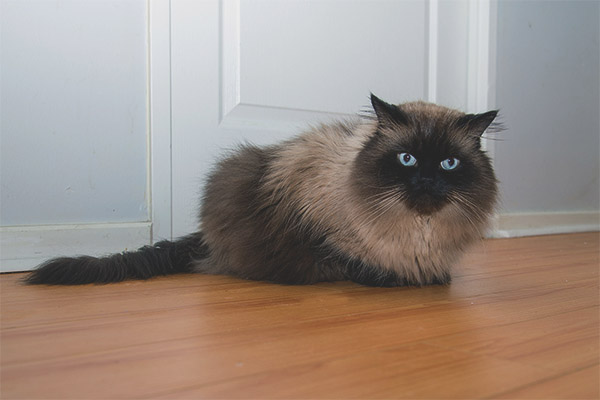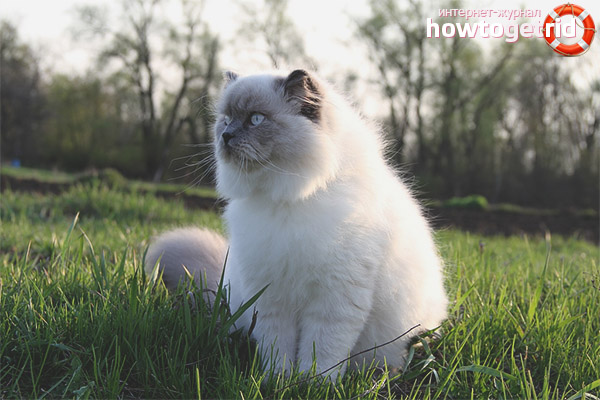The content of the article
Crossing the Persian breed with a Siamese was a brilliant idea. The result was magnificent to the joy of cat fans: a new breed appeared, called “Himalayan” - with a sweet temper, fluffy delicate hair, but a strong body like those of the Persians, and with blue expressive pensive eyes and unusual color, which gave the Siamese originators of the breed.
Long road of breed to official recognition
Conceived to cross a Siamese cat with a black Persian in the 30s of the twentieth century, Dr. K. Keller and V. Cobb. They were interested to check which genes will be the strongest and will be able to be passed on to future generations. The first litter gave kittens black, with short hair. It seemed that the genes responsible for colorpoint and long hair would be recessive.
But the American breeder decided to continue the idea. M.Gofort achieved the fact that a Persian with a long hair, but with a Siamese colorpoint, was born. This significant date dates back to the 50th year of the twentieth century. Future parents with the most expressive Siamese color and the thickest hair were selected for crossing. 7 years have passed, and the breed was officially recognized as a Himalayan thanks to a special color.
In Great Britain, they also engaged in breeding such a breed, and in 1955 there appeared a long-haired colorpoint, which was distinguished by the fact that it had a face not so flattened, and its color was more intense.
New decent breed to bring quite easy. But also many difficulties need to be passed in order for it to be recognized by serious world associations and included in the catalogs on a par with other breeds. In the 60s, the Himalayan cat was officially recognized as a pedigree by such famous organizations as the CFA and ACFA. However, the CFA community in 1984 decided to unite both Persian and Himalayan breeds into one group. Outraged by this decision, breeders have created their own organization - NCFA. Of course, in their documents these two breeds are in different lists.
How to recognize the Himalayan breed
For lovers of the Himalayan labor is not to distinguish these beauties among others. But there are, as for other breeds, certain strict standards.
Most of the felinological organizations believe that there is a single standard for such breeds as the Himalayan, Persian and exotic Shorthair. There are only minor differences that are in wool - length and color.
You can describe the Himalayan breed as follows:
- Weight. If the animal is medium or large in size, it will weigh from 4 to 6 kg. But there are cats and larger ones.
- Head. The shape resembles a smooth dome, round and wide. Sizes are large or medium, but proportion with respect to the body. Cheeks distinct, full. Jaws are quite wide and powerful. The bite is good. Chin powerful. In general, the muzzle is short, but wide, noticeably flattened. Maybe a little noticeable or pronounced stop, that is, the muzzle resembles a toy. If the foot has a pronounced manifestation, the nose is too depressed and almost imperceptible. It is imperative that the so-called dark mask be marked on the face, and it should not go beyond the neck and chest.
- The ears are small, the tips are rounded, set wide apart.
- The nose should be equal both in length and in width, snub. The profile must be on the same line with the chin and forehead. Nostrils open.
- Eyes slightly arched, large and round. Set wide apart. Color plays an important role in determining the standard - all shades of blue can occur, no other colors are allowed.
- The body belongs to the type of "Cobby". It is strong, with a noticeably rounded tummy, and can also be large. The chest is low, the neck is very short, but thick and muscular.
- Paws are short and straight. But more long-paws are allowed, who inherited this length from Siamese ancestors. The bone is large, the muscles are strong and well developed. The pads are round-shaped and rather large.
- The tail must be straight and proportionate to the length of the body.
Wool color is important!
Wool and color should be given special attention.
Himalayan breed due to the thick undercoat and long fluffy hair all over the body looks volume. There is a very lush collar. The main difference of the breed is in the colourpoint coloration, which means: the head, paws and tail are colored noticeably darker than the rest of the body.Necessary color is formed in kittens not immediately, but only when they begin to grow up. Only by the age of two and three, it appears in all its glory.
Basically, this breed has a white or cream colored coat. Points are shades of purple, red, brown. Chocolate and purple are valued the most, as they are quite rare, and in order to get such colors, parents must be of the same color.
Sometimes it is difficult to distinguish this breed from Persian, but you should look at the blue eyes of the Himalayan cat and color, seeing the black contrast between color and background - these are the factors that determine the breed first and foremost.
The most famous colors are:
- Standard blue, bloupoint.
- Seal Point is distinguished by dark brown points, and the paw pads must be dark brown.
- Lilac is a blur blue and body color is noticeably brighter and whiter.
- Chocolate has dark brown points, body color is brighter and lighter, unlike silpoint. The pads are required to be pink.
- Auburn - has the same points.
- Cream - differs from the red more pale shade.
There are Himalayas with the figures of "tabby", "torti".
Cat character

Breeders and owners of this breed are satisfied with the character of cat pets, as they are distinguished by a soft, calm and balanced disposition. Cats are very devoted to the owner, like to be constantly with him, especially on his knees, requiring affection and attention. But they can be jealous of the owner, not allowing people and other pets to him. Although with other animals get along quite peacefully, and loneliness is endured very badly. The mood of the household is keenly felt, trying to adjust to it. These cats can be safely left with the children, they will take an active part in the games with the child, but because of the short legs and the chunky body, jumping is not easy for them, and they will not be able to jump high. Kittens can be fun to play even with a regular sheet of paper. From an early age, these pets are obedient and undemanding.
It must be remembered that in small enclosed spaces, Himalayan cats are under great stress. Love, like many animals, bask in the sun.
Necessary care
- Pet Himalayan requires everyday grooming.If it is not combed out, the delicate hairs will begin to tangle, and it will be necessary to remove the formed mats. For this procedure, you need special comb, natural bristle brush and comb, with small and thick teeth, which are sold in any pet store.
- Because of the flattening of the face, the animal may show pathology of the lacrimal canal, therefore it is necessary to periodically wipe its eyes. If the stop is pronounced brightly, then the nasal canal is poorly formed, most often in this case, defects in the nasal septum appear.
- This breed is very fond of water procedures, and this is good news for their owners, as the animal's fur is distinguished by active sebaceous secretions.
Frequent diseases
Feeding recommendations
Many diseases can be avoided if a responsible approach to the process of feeding. In the bowl should be food, both dry and wet, rich in vitamins and trace elements.Natural feeding will not be enough. Therefore, you should definitely buy special cat food from trusted vendors.
The Himalayan breed does not have a long lifespan. On average, they live no more than 12 years.
Video: Himalayan cat












To send